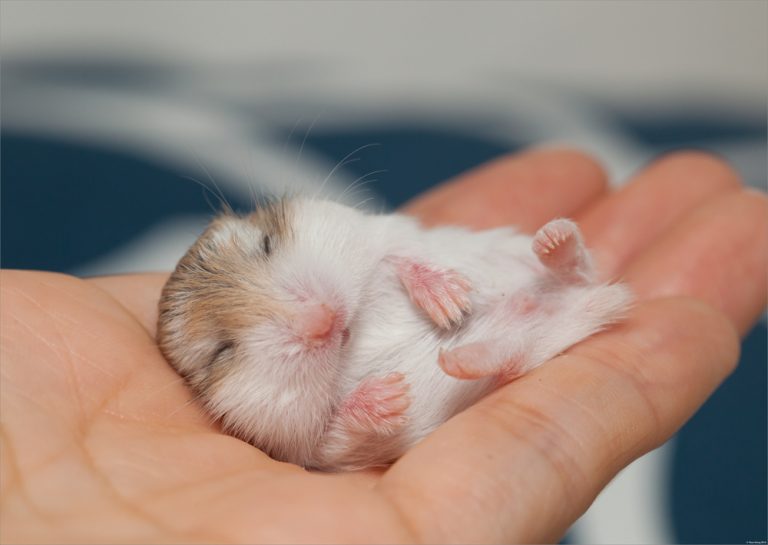Hamster Cage Guide | Choosing a Cage for a (Dwarf) Hamster
Before you get a hamster (Syrian or dwarf hamster), you should get an appropriate cage. A good cage that is large enough is an essential product for hamsters. However, not all hamster cages found in pet stores are large enough for (dwarf) hamsters.
A hamster cage should be at least 30 gallons. The minimum cage size for both Syrian hamsters and dwarf hamsters should be 2,900 cm² (450 sq inches). The cage should have a height of at least 40 cm (16″). A vivarium (made of glass) is the recommended cage for keeping pet (dwarf) hamsters.
Hamsters need to be kept in a large cage with enough height to create a deep layer of substrate (bedding). Although dwarf hamsters are smaller than Syrian hamsters, they both need large cages. The bigger the cage, the better.
Most hamster cages are much smaller than the minimum size I mentioned above. For dwarf hamsters, there are even smaller cages in pet stores that should never be used.
Not only does the size of the cage matter, but also the material and the place where you put the cage is important.
In this article, you’ll learn about the requirements for the habitat of pet hamsters (including the minimum size), the cage location, and more importantly, the best hamster cages.
This site contains affiliate links to products we recommend and use ourselves. We may receive a commission for purchases that you make through these links. If you’re interested in learning more about our affiliate links, please visit our (affiliate) disclaimer.
Natural Habitat of Hamsters
Syrian hamsters aren’t social animals. In captivity, it’s best to keep one Syrian hamster in a cage. The same goes for Chinese (dwarf) hamsters, which are also best kept alone to avoid any problems.
Other dwarf hamsters are social animals and should be kept in a small group. Most owners will keep a pair of dwarf hamsters, although a small group is better and is more natural. I would advise getting only a pair of hamsters for people who aren’t used to keeping dwarf hamsters.
Hamsters and dwarf hamsters will create burrows with tunnels. Sometimes they will also use abandoned tunnels that were made by other animals.
There isn’t a determined size of the hamsters’ territory, but it has been determined that Syrian hamsters have a considerable distance between home burrows. The closest between burrows in the wild was 118 m, according to Animal Diversity Web.
Hamster Cage (Size & Material)
Although there isn’t an exact territory size for wild hamsters, it’s needless to say that their natural territory is much larger than the hamster cages we keep them in.
When you keep an animal as a caged pet, there will always be restrictions on their territory and freedom of movement. This doesn’t mean that you can’t keep hamsters in a cage (a lot of pet hamsters were kept for decades in small cages). It does mean that you shouldn’t keep hamsters in a cage that is too small for them.
As a responsible and caring owner, you should get a hamster cage suitable for your hamster. Such a cage should be:
- as large as possible (minimum size requirements)
- made from the right materials
Minimum size of a hamster cage
In general, both science, animal welfare societies, and the hamster community have very different ideas on a hamster cage’s right size. Of course, the size of the cage should depend on the number of hamsters you keep.
To determine the minimum size for a hamster cage, I will give you a little bit of information about the recommended (minimum) cage size. This minimum size might change as research and insights in hamster needs are more understood.
Before we get into the minimum size, you can think back on the last time you visited a pet store. What kind of hamster cages was available in these stores? Where they large or small? If you can’t remember them, you can also look at Amazon’s most popular hamster cages.
Most hamster cages are small and are 10-gallons or smaller. Some brands also have tunnels and tubes to connect different parts of a cage. These small cages are not suitable for hamsters and dwarf hamsters.
So how do we determine a suitable minimum cage size? Let’s take a look at what experts and authorities have to say.
Hamster societies and groups
There are a lot of local and national groups and societies that have formed around the pet hamster. The most well-known groups that also have an online presence are:
According to the National Hamster Council, hamsters should be housed in “as big as cage as possible”. The council recommends that you get a big enough cage, depending on the hamster species and the number of hamsters you keep.
The California Hamster Association mentions that the minimum size requirement for hamsters is 450 square inches (or 2,900 square centimeters).
Animal welfare organisations
The most authoritative animal welfare organizations are:
- American Society for the Prevention of Cruelty to Animals
- Animal Humane Society
- PETA
- Royal Society for the Prevention of Cruelty to Animals
According to the American Society for the Prevention of Cruelty to Animals (ASPCA) recommends that you keep a Syrian hamster in a solid-bottom wire cage or an aquarium with a mesh top (minimum of 10 gallons). According to the society, dwarf hamsters can be kept in cages that are made for mice. However, it’s unclear how large this size is, as the society recommends a 10-gallon cage for mice.
The Animal Humane Society gives the same advice. They recommend keeping hamsters (without distinction between dwarf hamsters and Syrian hamsters) to be kept in a solid bottom wire cage or a 10-gallon aquarium with a wire mesh cover.
PETA doesn’t give a specific minimum cage size but recommends a 2 ft square cage for hamsters. The website doesn’t mention the cage size for dwarf hamsters, which are social and need to be kept in groups (except for the Chinese hamster).
Finally, the Royal Society for the Prevention of Cruelty to Animals (RSPCA) doesn’t give any specific minimum cage size and recommends to “buy as large a cage as you can”.
National regulations
There are strict policies on the minimum size of cages for hamsters and other animals in some regions. These regulations are mostly for sellers of pets and laboratory animals. Some strict and interesting minimum cage sizes can be found in the following regulations:
- Animal Welfare Regulations (England)
- Swiss Animal Protection
- European Convention for Protection of Vertebrate Animals
According to the Animal Welfare Regulations in England, the minimum area for 1 to 4 hamsters is 680 cm² with a minimum cage height of 25 cm and a minimum cage depth of 25 cm. A higher minimum standard sets a minimum area of 750 cm² (up to 4 hamsters).
The Swiss Animal regulations set a minimum surface area of 0.18 m² for one Syrian hamster. The regulation doesn’t give a minimum surface area for dwarf hamster species.
Lastly, the European Convention for Protection of Vertebrate Animals sets a minimum cage size of 800 cm² (for laboratory animals). The floor area per hamster should be between 150 cm² and 250 cm² depending on its weight. The minimum cage height is determined at 14 cm. There doesn’t seem to be a differentiation between Syrian hamsters and dwarf hamsters.
Hamster forums
A lot of information can be found on forums that are visited by fellow and experienced hamster owners. But this information isn’t always backed by science and is often more an anecdote than real science.
The most popular forums about hamsters are:
On forums, there isn’t always a consensus on the minimum size. Most forum members on Hamster Hideout recommend a minimum cage size of 450 square inches (2,900 square centimeters). The members on Hamster Central seem to recommend a cage with a floor area of 465 square inches (3,000 square centimeters).
Conclusion
So, there are very different views on the minimum size requirements for hamster cages and most recommendations only deal with Syrian hamsters and not dwarf hamsters.
I would recommend that you get a cage of at least 450 square inches (2,900 square centimeters) for both Syrian hamsters and dwarf hamsters. But bigger is undoubtedly better. As for height, I would recommend a minimum of 40 centimeters (16 inches).
My preference would go to a 10,000 cm² (1,550 square inches) for a solitary Syrian hamster and 7,500 cm² (1,160 square inches) for dwarf hamsters. A cage with a height of at least 60 cm (24 inches) is better to create a layer of substrate (bedding) suitable for burrowing.
Types of hamster cages
Hamster cages come in different types. There are wire cages, plastic cages with a mesh cover, habitats with tunnels, and tubes. But a much lesser-known kind of cage for hamsters is a vivarium, a glass tank with ventilation (through the top).
To find the most suitable cage type for hamsters, you’ll have to take into account different factors:
- cage material
- ventilation
- ease of cleaning
- suitability for burrowing
I’ll discuss these factors for three different cage types:
- wire or mesh cage
- tank with cage topper
- vivarium
I won’t get into the cage types with tunnels and plastic tubes to connect different parts. These cages aren’t suitable for hamsters and don’t provide enough floor area for hamsters.
Wire or mesh cage
The typical cage for pet rodents is a wire or mesh cage with a plastic or metal base. This base only allows for a thin layer of bedding and has vertical or horizontal bars all around the cage.
As you’ll notice from the table below, wire or mesh cages are generally good cages when it comes to cage material, ventilation, and ease of cleaning.
| Factor | Description |
|---|---|
| cage material | plastic or metal |
| ventilation | good ventilation |
| ease of cleaning | easy to clean |
| suitability for burrowing | not suitable, unless deep base |
But the main problem with this cage type is that the base isn’t deep enough to create a deep layer of substrate (bedding), which is necessary for hamsters. The bedding can also be easily be pushed out of the cage, which causes a mess.
Most wire cages also aren’t big enough and need to be combined to create a large enough floor area.
However, if the cage’s size is large enough (at least the above-mentioned minimum size) and has enough space for burrowing, you could use a wire cage like a hamster cage.
Tank with cage topper
Hamsters are, just like gerbils, burrowing pets and they need a deep layer of substrate (bedding). The most popular cages for gerbils are tanks or tanks with a cage topper. The same cage type can be used for hamsters.
A tank with a cage topper is essentially a two-part cage. The first part is a tank or aquarium that replaces the plastic base of the wire cage. The tank is deeper than a base and can be made of glass or plastic. The second part is the cage topper, which is the same as a wire cage with metal bars and clips to hold it onto the tank.
| Factor | Description |
|---|---|
| cage material | glass or plastic (tank) and metal (topper) |
| ventilation | good ventilation |
| ease of cleaning | easy to clean |
| suitability for burrowing | suitable |
Tanks with cage toppers are suitable cages because they (usually) are made of chew-proof material and have a deep base to allow burrowing. They have adequate ventilation in the top part of the cage and are easy to clean. However, because they still got bars, it’s possible that bedding gets kicked through the bars.
If the tank and the cage topper is large enough, you can use a tank with a cage topper as a hamster cage.
Vivarium
A vivarium is a cage that is made from glass with a frame. The frame can be made from materials like plastic, wood, or metal. The vivarium looks a bit like a terrarium for reptiles or an aquarium. But it’s essential to have a mesh cover on top to provide ventilation.
| Factor | Description |
|---|---|
| cage material | glass (tank) and metal/wood/plastic (frame) |
| ventilation | medium ventilation |
| ease of cleaning | more difficult to clean |
| suitability for burrowing | most suitable |
A vivarium is – in my opinion- the most suitable hamster cage. It provides enough space for burrowing and limits the risk of bar chewing.
You do have to make sure that there is enough ventilation in the cage. The glass also is heavier to move and can be more difficult to clean. A vivarium is usually more spacious but also more expensive than other cage types.
Cage Location
Wild hamsters live in harsh conditions, but it’s best to remove any extra stress to prevent health problems in captivity. You should place the cage in a location where it’s safe for your hamsters and where you can still enjoy them.
The following things need to be considered when it comes to cage location:
- exposure to direct sunlight
- natural day- and night light cycle
- room temperature
- accessibility to other pets
- placement of the cage
Importance of light for cage location
Hamsters are nocturnal pets and sleep for most of the day. They only wake up at twilight and will be active at night. Hamsters use light in the room where the cage is to guide their sleeping habits.
It’s best to keep the cage in a room with a natural day- and night light cycle. The most obvious place is the living room, where indirect sunlight can come in during the day.
You should never put the cage in direct sunlight. Direct sunlight can heat the cage very fast. This is most true for a glass vivarium but is also applicable to other cage types. Your hamster won’t be able to escape the heat and can get serious health issues, like a heat stroke or stress from it.
Importance of temperature on cage location
Hamsters live in an arid region in the wild. Temperature can get very high during the day, but it can also get very cold in a short period. During the day, hamsters will be less active and will sleep in their cool burrow. If they stayed outside during the day, they would get heat stress.
At night the temperatures can also get cold and hamsters have a coat of fur to keep themselves warm. Their ideal temperature range seems to be between 18 and 24°C (65 to 75°F), which is room temperature in most regions.
In most regions, you won’t have to take extra measures to get the right temperature. But you do have to be careful not to place the cage in naturally cold rooms (like a basement).
If you keep the cage in a room and temperatures get high (summer), you’ll need to cool the cage down. You can do so by relocating the cage or by using an air-conditioning or ventilation system in the room. Just make sure that the air-conditioning or ventilation isn’t near the cage.
If the temperatures get low (winter), you’ll have to keep your hamsters warm. You can do so by giving extra nesting material or by using a heater or heating system in the room. Again, don’t place the heater near the cage.
Importance of the placement of the cage
As you’ve chosen a room for your hamster cage, you’ll also need to make some considerations on how to place the cage. You should place the cage:
- on waist level or higher: hamsters are prey animals and have many natural predators. To prevent stress it’s best to approach them from the same level and that they’re always aware that you’re near them. If you reach your hamster from above, a hamster might get scared because it thinks you’re a predator (instinctive behavior).
- away from (predatory) pets: cats, dogs, and birds can pose a real danger to your hamsters. They can cause your hamsters to have stress and can sometimes open the cage or hurt your hamster through the bars.
- away from cold or heat sources: never place the cage near natural (direct sunlight) or artificial heat sources (heaters). Also, keep the cage away from cold sources (like air-conditioning).
Examples of unsuitable cage locations
Some cage locations are more suitable than others. To give you an idea of some “bad” locations, you can find some examples below. Of course, this will depend on the particular situation in your home:
- bedroom: hamsters are active during the night and use their wheel for a large portion of it. So, hamsters can make noises during the night and these noises might wake you up. For this reason, it’s better not to place the cage in your bedroom. It’s also better to keep the cage outside of the bedroom because it can lead to the development of allergies.
- garage or shed: garages and sheds are usually colder and are less frequented. The cold can cause health problems for your hamsters. Exhaust fumes from cars or motors are also hazardous for hamsters.
- kitchen: you should always keep your pets, including hamsters, out of the kitchen or any room where food is prepared or consumed. Keeping the hamster cage in such a room is unhygienic.
The above locations are also less suitable because you’ll not see your hamsters as much as when you house them in your living room. This can cause issues if you’ve got a cat or dog. In such a case it’s perhaps better to keep them in another room where you still can have enough contact with them.
Tips and Tricks for Choosing a Good Hamster Cage
Now you know almost everything to choose a good hamster cage, but some extra tips can help you make the best decision. Below you can find five handy tips that are important to know:
- bar spacing: hamsters and dwarf hamsters are small pet rodents and they can squirm through small openings. A wire cage should have a bar spacing of 1/2 inch for Syrian hamsters and 1/4 inch for dwarf hamsters.
- cage floor: wire or mesh floor isn’t suitable for hamsters because they will get injured when running on the floor. You can use bedding on the mesh and there are other ways to cover the mesh floor (like a platform or a cage mat).
- secure the cage doors: hamsters can escape the cage if the door isn’t secured. A lock to keep the hamster cage closed is often a cheap and easy solution to prevent an escape. It will also prevent your children from opening the cage door and accidentally letting the hamsters escape.
- double doors: a cage with double doors will make it a lot easier to clean the cage and feed your hamsters. This is more applicable to a vivarium than a wire cage, although some wire cages also have double doors.
- place for enough accessories: the cage should be at least high enough to place in a large enough exercise wheel in it. For Syrian hamsters, a wheel should have a diameter of (30 cm) 12 inches so the cage should be high enough to place it.
Recommended Hamster Cages
Most cages that are being sold for hamsters are too small and not suitable for them. Almost all cages have no or only limited space for a thick layer of substrate (bedding).
Hamsters don’t really need a lot of climbing space (or a vertical cage). However, to create enough flooring space, multiple levels are often made in hamster cages.
In my opinion, the best cage for hamsters is a vivarium. But if you can create a deep layer of bedding in another cage, you can also you such a cage.
To help you find the best hamster cage for your situation, here’s my recommended cages list. For this list, I chose cages with:
- a height of at least 40 centimeters (16 inches)
- a minimum floor area of 2,900 square centimeters (450 square inches)
This does mean that the cages have a minimum volume of 30 US gallons. If you want to calculate the cages’ volume below or from a self-made-tank, I would recommend this tank size calculator.
| Name | L (in) | W (in) | H (in) |
|---|---|---|---|
| Prevue Pet Products 528 Universal | 32.5 | 19 | 17.5 |
| Savic Hamster Plaza Hamster Cage, Silver | 40 | 20 | 20 |
| Carolina Custom Cages Large | 36 | 18 | 18 |
| Repti Zoo Reptile Glass Terrarium | 36 | 18 | 24 |
| Living World Green Eco Habitat | 39 | 24.5 | 23 |
Prevue Pet Products 528 Universal
The Prevue Pet Products 528 Universal is a horizontal wire cage that has a base of 6 inches deep. It’s large enough for hamsters but you might need to be careful that the bedding doesn’t get through the bars.
Savic Hamster Plaza Hamster Cage
The Savic Hamster Plaza Hamster Cage, Silver is another wire cage that has a deep base (6.5 inches) and has a floor area of 800 square inches. It comes with accessories, such as a wheel, but you should get a more suitable (larger) wheel.
Repti Zoo Reptile Glass Terrarium
The downside of an aquarium is that it’s often made of heavier glass and that it is difficult to move. Another good option is a terrarium for reptiles. These usually weigh less and have a screen top on them already.
The Repti Zoo Reptile Glass Terrarium comes for example in a size of 90 cm x 45 cm x 60 cm (36″x18″x24″). There’s also a version RK0119N that is 45 cm (18″) in height. However, this version only allows for a layer of 9 cm (3.5″) up to the double doors while the RK0120N has a place for a layer of 18 cm (7″).
Be aware that the double doors can’t really be opened if there’s a thick layer of bedding in it. The larger version does allow for a fairly deep layer that isn’t achievable in most other cages that are being sold.
Carolina Custom Cage Large
If you’re looking for a terrarium with enough space to create a 30 cm (8″) layer of bedding I would recommend a terrarium from Carolina Custom Cages. This version has a base of 8 inches.
If you want to have even more space you should get the Bio Deep. The Bio Deep cage has 12″ between the bottom and the start of the double doors. The terrarium is originally for reptiles but can also be used for burrowing pets such as hamsters.
Living World Green Eco Habitat
Similar to the Skyline terrarium the Living World Green Eco Habitat can be used as a hamster cage. It is very large and provides a lot of space to put in a deep layer of substrate (bedding). It’s also a fairly cheap option compared to the usual terrarium for reptiles.
Related Questions
Is a tank or cage better for a hamster?
A tank or vivarium is better for hamsters than a cage. A tank will allow your hamsters to have a deep layer of bedding and gives a clear view of them. It also eliminates bar chewing but does need to have enough ventilation to prevent the buildup of odors.
Are hamsters happy in cages?
Hamsters were being kept in cages for decades and can still be kept in cages. But your hamster will need to get a large cage and plenty of things to do to stay happy. If you notice any signs of stress or boredom, such as bar chewing, please upgrade your cage and include enough bedding and toys.
What kind of cage does a hamster need?
A hamster can be kept in a variety of cages, such as wire cages, tanks with cage toppers, vivariums. The best cage for a hamster and dwarf hamster is a vivarium. Wire cages are an acceptable alternative if you can provide a deep enough base.
Want to Learn More?
If you’re interested in learning more about hamsters as pets (or other pocket pets), please read the following articles:
If you’re interested in getting hamsters as pets you should also definitely read our beginner’s guide to keeping hamsters as pets and our hamster care guide.





